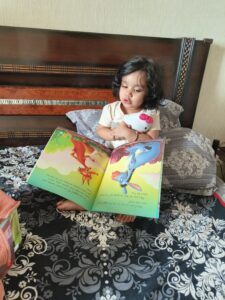Montessori schools are becoming increasingly popular all over the world. It focuses on providing a hands-on, self-directed, and social learning environment for children from ages 0 to 12.
One of the most important principles of Montessori education is that children should learn by doing. This means that children are allowed to explore and learn through experimentation. This is one reason why Montessori schools encourage writing before reading.
Montessori education believes that introducing writing prior to reading helps children develop their own language skills to decode complex words and their sounds.
As a parent, we are always curious to know how to encourage a child to read and develop the habit of book browsing and reading. Children excel in academics who follow Montessori education techniques.
So, here we will explain why Montessori education encourages writing before reading and how?
Why does Montessori Education Encourage Writing before Reading?
It is essential to teach children how to write before they are taught how to read. Writing skills help children develop a deeper understanding of language, which in turn helps them learn how to read.
If a child doesn’t understand what a letter looks like and how to write them, then how can they identify and read them?
Figuring out how to write first allows young minds to endeavor reading when they’re prepared for it and inquisitive about it, which is the best chance to learn. Reading with their own curiosity fosters a positive relationship with reading and encourages a child for the same quite often.
Requisites for Reading and Writing: 3 Es
- Efficiency– While doing the writing, unknowingly, a child is also learning to read. The brain of the kids looks for patterns and not the meaning of the letters. That is the reason when they know to write, it becomes easier to read.
- Effectiveness– As the kids begin to write, they generate an understanding of the pattern, alphabet, and numbers, and hence when they read, they read with a sense of indulgence and not memorization.
- Engagement– A child is motivated when they read with a sense of understanding and this keeps them engaged in writing and reading simultaneously. They are excited when they begin to recognize the alphabet and further the words.
8 Benefits of Teaching Writing Before Reading to a Child
- Teaching children to think critically and creatively before they read, children should know how to write than just using vocabulary words.
- Teaching writing before reading also helps children understand the connections between words and sentences, which will help them when they start learning how to read.
- Writing gives children a chance to practice thinking about their thoughts, feelings, and ideas in a way that reading cannot.
- Children learn how to use words in a way that differs from the linear, left-to-right process of reading words on a page or screen.
- Writing can encourage children to be more empathetic and understanding of the world around them by giving them the chance to explore their own experiences in words
- Writing can help children build vocabulary skills by practicing using new words and exploring new concepts through written language
- Writing helps develop literacy skills by giving students practice with sentence structure, punctuation, spelling, paragraph structure, paragraphs, and dialogue
- Writing before reading helps a child to identify numbers and letters easily, as they know what they look like through their senses.
How writing is introduced before reading in a Montessori classroom?
- Introducing songs, rhymes, and music- A child enters a preschool at an age of 2 to 3 years and there they begin listening to varied sounds and watching various patterns through blocks, toys, etc. Gradually, their intellectual level starts developing and they start recognizing the symbols.
- Sandpaper letters and sound trays – At the age of 3-4 years, Montessori schools introduce phonic sounds of alphabet letters using sandpaper letters, which a child traces with their finger, as they say, and sound trays.
- Moveable alphabet box – Once the child learns to trace and recognize the letters, they are introduced to a Moveable alphabet box to build words to copy the words written on word cards, CVC cards, sight words, and so on. They are also introduced to the concept of vowels and consonants at this stage.
- Rice Trays or salt trays or sand trays – In this stage, the Montessori schools encourage the child to refine their fine motor skills and prepare the child’s hands for writing. This is done by introducing pre-writing activities such as writing and tracing letters in rice/ salt/ sand trays with their fingers. Children are also encouraged to trace letters between the lines or in the air.
- Writing on paper or board – When the child is ready to begin writing in earnest, they use a chalkboard with wide lines and start writing on paper.
They form spellings based on the sounds at the next level. At this young age of 4-5 years, children have a vast area in the brain to fill with patterns, words, and sounds. The thoughtful process begins and the young brain gets to work and starts resembling the alphabet or words in the books. They try to pronounce them based on sounds. They naturally start browsing books and reading.
These activities are repeated at regular intervals of time that allow the child to understand the shape and sound of each alphabet.
This is how a child starts writing and recognizing each alphabet with its sound. And as young learners identify the pattern and phonic sounds, they begin to decode reading.
Some Prewriting Activities You Should Try at Home:
Pre-writing activities are usually the best place to start before learners are ready to begin on letter sounds.
- Sand art: introduce them to tracing and writing lines, shapes, etc in sand using their fingers.
- How to use tongs and tweezers: these practical life activities help a child to strengthen their hand muscles and form a pincer grip.
- Clothespin: there are many activities you can do with clothespins such as identifying letters when called out, color recognition and drying clothes. Also, there are many benefits to it. A child enhances their fine motor skills, sensory skills, pincer grip formation, and much more.
- Pegboard puzzles: This activity also helps to prepare a child’s hand for writing as a child holds the peg using a pincer grip.
- Playdough: it is an excellent activity that enhances the working of the hands as children need to roll, pull, twist, and tear the dough to make a masterpiece. Plus, children love it.
- Tearing and cutting activity: Using how to run a scissor helps in enhancing pre-writing skills as it strengthens the hand muscles.
- Transfer activities: Practical life activities such as transferring water using an eyedropper, transferring grains from one bowl to another using spoon, etc. help to prepare a child’s hand to grip the pencil for a longer duration.
There is a logic and reason behind all the Montessori activities which act as a stepping stone in a child’s overall development. This is also a reason why Montessori children excel in the outside world.
Final Words
Through research and observation, the development of writing skills has been studied for over 100 years. This is because, in order to learn how to write well, children must be able to reflect on their own thoughts and experiences. Writing is an essential component of academic learning that can help students develop their academic skills in many ways, such as vocabulary, sentence structure, and punctuation. After reading this article, don’t you agree with us that a child must learn how to write before learning how to read?
Do share your thoughts below!
Few tips for parents (FAQ)
-
How can I encourage my child to write?
Tell your child that you are interested in what they have to say, ask them questions about what they are reading, or spend time writing together. Encourage your child to be creative by setting up a “No Rules” zone in their room. It can be a space where they can draw, read, or write without any limitations.
-
How do I know if my child should take their writing seriously?
Some signs that your child is not taking what they are writing seriously are when the story is filled with inaccuracies about school life and spelling mistakes that they may not realize. If this is the case, encourage your child to think about how they could improve their writing.
-
What should my child’s writing routine look like?
A good writing routine includes a mix of different mediums: handwriting, tracing using pencils/markers so that there is always a new way to express themselves. Another suggestion is to incorporate their favorite books into the routine so that your child can have a more fluid experience with their writing. Or take them to a beach or play area where sand is available and ask them to write in the sand. Children learn better while playing.







